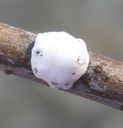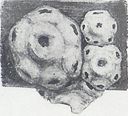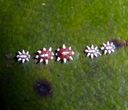Wax Scales
Ceroplastes
Classification
- Phylum: Arthropoda
- Subphylum: Hexapoda
- Class: Insecta
- Order: Hemiptera
- Suborder: Sternorrhyncha
- Superfamily: Coccoidea
- Family: Coccidae
- Genus: Ceroplastes
Pronunciation
How to pronounce Ceroplastes: //ˌkɛroʊˈplæstiːz//
These audio files are automatically generated. While they are not always 100% accurate, they are a good starting point.
Images






Summary
Ceroplastes is a genus of wax scales in the Coccidae family, consisting of over 130 described species. They are recognized by their protective waxy coating and can be both beneficial and harmful in various ecosystems depending on the species and the host plant involved.
Physical Characteristics
Ceroplastes species are known for their waxy, sometimes sticky covering which can be yellowish, white, or pink in color, providing camouflage and protection.
Identification Tips
Look for the distinctive waxy covering on the body, often resembling small, waxy dots or clusters on plants.
Habitat
Ceroplastes species typically inhabit a variety of environments where host plants are available, including gardens, forests, and agricultural areas.
Distribution
Ceroplastes species are distributed globally, with many species found in tropical and subtropical regions; four have been introduced to various regions.
Diet
They feed on plant sap, extracting nutrients from the phloem of their host plants.
Life Cycle
Ceroplastes undergo a complete metamorphosis, starting from eggs which hatch into nymphs, progressing through several instar stages before becoming adults.
Reproduction
Most species reproduce sexually, with females laying a large number of eggs protected under their waxy coating.
Predators
Natural predators include lady beetles, lacewings, and parasitic wasps.
Ecosystem Role
Ceroplastes species play a role in the ecosystem as herbivores, impacting plant health and serving as food for predators.
Economic Impact
Some species can be pests in agriculture and horticulture, leading to damage on crops and ornamental plants.
Collecting Methods
- Handpicking
- Sticky traps
- Insect nets
Preservation Methods
- Ethanol preservation
- Dry preservation
Misconceptions
Some people may confuse the wax scale with harmless waxy substances produced by certain plants or other organisms.
Tags
- Ceroplastes
- Wax Scales
- Coccidae
- Hemiptera